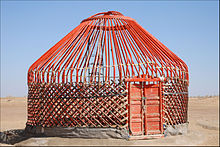 Global Information
Global InformationYurt information






A yurt (from the Turkic languages) or ger (Mongolian) is a portable, round tent covered and insulated with skins or felt and traditionally used as a dwelling by several distinct nomadic groups in the steppes and mountains of Inner Asia.[1] The structure consists of a flexible angled assembly or latticework of wood or bamboo for walls, a door frame, ribs (poles, rafters), and a wheel (crown, compression ring) possibly steam-bent as a roof. The roof structure is sometimes self-supporting, but large yurts may have interior posts supporting the crown. The top of the wall of self-supporting yurts is prevented from spreading by means of a tension band which opposes the force of the roof ribs. Yurts take between 30 minutes and 3 hours to set up or take down, and are generally used by between five and 15 people. Nomadic farming with yurts as housing has been the primary life style in Central Asia, particularly Mongolia, for thousands of years.
Modern yurts may be permanently built on a wooden or concrete platform; they may use modern materials such as metal framing, plastics, plexiglass dome, or radiant insulation.
- ^ Kingsley, Patrick; Levene, David (2017-01-05). "Nomads no more: why Mongolian herders are moving to the city". The Guardian. Retrieved 2022-12-12.